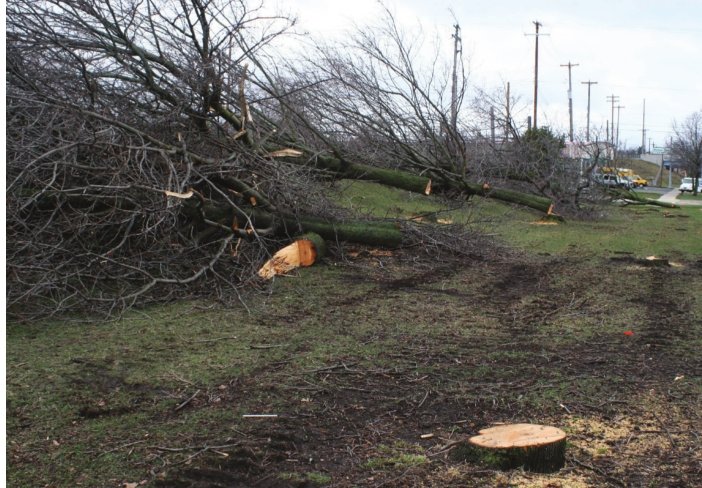"It's a massacre," she said.
Dozens of toppled trees, some of them 50 to 100 years old, covered the park's east and southern border. Shredded sugar maples with more than 70 exposed rings bent to the ground. Whale-sized conifers lay on their sides.
Along Michigan Avenue, at the north edge of the park, the sidewalk was lined with stumps, their corresponding trees heaved over the fence.
It wasn't just Alice, a Lansing resident, who got a shock last weekend. I stopped by the park Sunday afternoon and Monday morning. On both visits, every few minutes, another passerby stopped to rubberneck at a wasteland of some 200 fallen trees — the first major sign of Lansing's biggest-ever, $380 million development, Red Cedar Renaissance, a complex of hotels, retail, restaurants and student housing planned for completion in the next two years.

One of them was a woman named Jess, also of Lansing, who checked back to survey the scene after riding by on a bicycle Friday, the day the trees along Grand River Avenue went down. She mouthed a single word to the crew from E.T. MacKenzie contractors: "Why?"
"We're going to make it better," a worker told her.
That's the message developers Joel Ferguson and Columbus-based Frank Kass, along with Ingham County Drain Commissioner Pat Lindemann, want to send, although there was no explanatory notice at the park last weekend to cushion the blow for shocked pedestrians.
The massive development, paired with an ambitious, ecology-conscious drain project that would restore native habitat and block an estimated 50,000 pounds of pollutants from entering the Red Cedar River, has the support of many community leaders.
Lindemann pointed out that Lansing voters and the City Council approved the sale of the park to developers.
"By a public process, with numerous public hearings, we have gotten confirmation from the public that they want the project," he said.
Federal law played an unusual role in the Easter weekend clear-cut. For ground to be broken on the project this summer, as developers hope, the trees had to be cut down by the end of March. Otherwise, two endangered species of bats — the Indiana brown bat, federally listed as endangered, and the northern long-eared bat, listed as threatened — might have roosted in the trees, after wintering in caves south of Michigan. Rather than delaying the project another year, the trees were cut down last week to avoid a summer "taking" (killing roosting bats) and a run-in with the U.S. Fish and Wildlife Service.
"If there's a stop sign, you have to stop," Chris Stalkowski of Ferguson Development said. "The law requires anybody, not just developers, to put a stay on removal of old-growth trees from April through September."
The bats hibernate in huge caves, mostly in southern Indiana, until spring, when they disperse throughout the Midwest.
The bats will find other places to roost, in the parkland to the south of Red Cedar Park or in the fitting rooms at Sears across the street (not really).
The bats complicated the timing of the tree cutting in more ways than one. Monday morning, angry Lansing resident Gary Novak was among the people who stopped to survey the carnage.
Novak was incensed that the trees were mowed down before the city finalized the sale of the former golf course to the developers.
The development agreement is still being worked out and will have to be approved by the City Council, Michigan's Department of Environmental Quality, the Michigan Economic Development Corp. and other entities.
"These are our trees," Novak said. "It's still a city park. How do they get away with that?"
Inquiries to the city attorney's office were not returned.
Lindemann said the shock over the cutting is understandable, but the end result will be "1,000 times better."
"You look at [Red Cedar Park] and see a green space, but it's a pretty dead zone, compared to what the live zone is going to be," he said. "The ground is full of arsenic, really bad chemistry in there we don't want. We have to pull it out and dispose of it properly."
Lindemann said about a thousand trees will be planted on the combined Red Cedar Renaissance/Montgomery Drain site. He said 88 trees were cut down for his drain project and over 100 trees were cut down by the developers, including overgrown dogwood bushes and other ornamental trees planted for the golf course.
Lindemann declared the park an ecological "dead zone" and plans a major restoration to native habitat, with ponds and meadowlands that will be home to frogs, waterfowl and other wildlife.
"When I build those ponds, you'll see 15 blue herons down there every day," Lindemann said. "Frogs will wake up the people staying in those new hotels. You'll see kingfishers and birds of prey, steelheads and salmon in the river, smallmouth bass going crazy in that river."
Lindemann will spend much of spring and summer explaining the Montgomery Drain project at a series of public hearings. It could cost as much as $30 million and a draft report is expected in April. If last weekend is any indication, he'll have to answer for last weekend's tree massacre more than once.
Sunday, after I said good-bye to Alice, she headed deeper into the park.
"I'm going to mourn," she said.
Before I could get back to my car, another bicyclist hailed me over.
"What happened here?" she asked. She listened carefully as I explained about the development and the bats.
"It seems a bit excessive," she said, and continued along Grand River, past a block-long row of stumps.
Support City Pulse - Donate Today!
Comments
No comments on this item Please log in to comment by clicking here